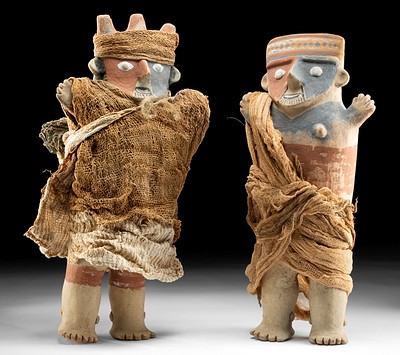Chinese Tang Dynasty Polychrome Horse / Female Rider
Lot 78d
About Seller
Artemis Fine Arts
686 S Taylor Ave, Ste 106
Louisville, CO 80027
United States
Selling antiquities, ancient and ethnographic art online since 1993, Artemis Gallery specializes in Classical Antiquities (Egyptian, Greek, Roman, Near Eastern), Asian, Pre-Columbian, African / Tribal / Oceanographic art. Our extensive inventory includes pottery, stone, metal, wood, glass and textil...Read more
Categories
Estimate:
$2,400 - $3,600
Absentee vs Live bid
Two ways to bid:
- Leave a max absentee bid and the platform will bid on your behalf up to your maximum bid during the live auction.
- Bid live during the auction and your bids will be submitted real-time to the auctioneer.
Bid Increments
| Price | Bid Increment |
|---|---|
| $0 | $25 |
| $300 | $50 |
| $1,000 | $100 |
| $2,000 | $250 |
| $5,000 | $500 |
| $10,000 | $1,000 |
| $20,000 | $2,500 |
| $50,000 | $5,000 |
| $100,000 | $10,000 |
| $200,000 | $20,000 |
About Auction
By Artemis Fine Arts
May 19, 2022
Set Reminder
2022-05-19 10:00:00
2022-05-19 10:00:00
America/New_York
Bidsquare
Bidsquare : Fine Antiquities | Ethnographica | Fine Art
https://www.bidsquare.com/auctions/artemis-gallery/fine-antiquities-ethnographica-fine-art-9350
Featuring a very special collection of Fine Art from the Hollywood Hills, including Picasso & Rookwood ceramics! Also included are many fine examples of classical antiquities, ancient, and ethnographic art from cultures encompassing the globe. Artemis Fine Arts info@artemisgallery.com
Featuring a very special collection of Fine Art from the Hollywood Hills, including Picasso & Rookwood ceramics! Also included are many fine examples of classical antiquities, ancient, and ethnographic art from cultures encompassing the globe. Artemis Fine Arts info@artemisgallery.com
- Lot Description
East Asia, China, Tang Dynasty, ca. 618 to 906 CE. A pottery figure of a regal court lady on horseback, most likely a funerary object of symbolic import, skillfully mold-made and adorned with red, black, and white pigments, all standing upon a rectangular plinth. The equestrian female is dressed in an elegant garment and headdress. She holds her clenched right hand before her as if pulling on reins, while her left rests at her side. Naturalistically rendered, her round face features soft contours with slender eyes beneath a sweeping brow, a flat nose, and bow lips. Her untailored robe cascades loosely over her slender form, its flowing sleeves enveloping her arms as her hair is piled high atop her head - all characteristic of the period. The horse is standing upon all four hooves implying the rider has brought her noble steed to a halt. A special example from the Tang Dynasty displaying exceptional artistry and technique! Size: 10.8" L x 4.3" W x 13.4" H (27.4 cm x 10.9 cm x 34 cm)
Who can say enough about the influence of the horse throughout the history of China! The horse played a significant role in the unification of the Chinese Empire, as this animal enabled the ancients to communicate to parties near and far due to the great speed of these noble steeds. The horse also assisted the military to conquer distant lands and grow the empire. As the desire for stronger, faster breeds grew, the ancients imported horses from Central Asia, leading to the creation of the famous Silk Road.
The horse grew very significant during the expansion of the Tang golden age. This impressive charger served as both a symbol of imperial stability that engendered bountiful trade and prosperity for the expanding empire and the reward of military exploits to the west. The most cherished horses were raised in the western kingdom of Ferghana and known as "blood-sweating horses." These were delivered as tribute to the reigning emperor. In general, for the ancient Chinese, horses were a sign of wealth.
Tomb attendants like this one are part of a class of artifacts called mingqi - sometimes known as "spirit utensils" or "vessels for ghosts." They became popular in the Han Dynasty and would persist for several centuries. Alongside figures like this one were musicians, athletes, animals, and special structures. Even though they were mass produced, mingqi often show a high level of detail and naturalism. These were designed to assist the po, the part of the soul of the deceased that remained underground with the body while the hun, the other part of the soul, ascended. Caring for the po seems to have taken on a new level of meaning in the Han period, with more elaborate rituals and tomb construction arising.
Provenance: ex-Barakat Gallery, Beverly Hills, California, USA, acquired prior to 2000
All items legal to buy/sell under U.S. Statute covering cultural patrimony Code 2600, CHAPTER 14, and are guaranteed to be as described or your money back.
A Certificate of Authenticity will accompany all winning bids.
PLEASE NOTE: Due to recent increases of shipments being seized by Australian & German customs (even for items with pre-UNESCO provenance), we will no longer ship most antiquities and ancient Chinese art to Australia & Germany. For categories of items that are acceptable to ship to Australia or Germany, please contact us directly or work with your local customs brokerage firm.
Display stands not described as included/custom in the item description are for photography purposes only and will not be included with the item upon shipping.
#170894Professionally repaired with restoration over break lines and to tip of tail. A few stable hairline fissures to hind legs. Surface wear with nicks and abrasions as expected with age. Otherwise, excellent with impressive remining pigments.Condition
- Shipping Info
-
All shipping is handled in-house for your convenience. Your invoice from Artemis Gallery will include shipping calculation instructions. If in doubt, please inquire BEFORE bidding for estimated shipping costs for individual items.
-
- Buyer's Premium



 EUR
EUR CAD
CAD AUD
AUD GBP
GBP MXN
MXN HKD
HKD CNY
CNY MYR
MYR SEK
SEK SGD
SGD CHF
CHF THB
THB














